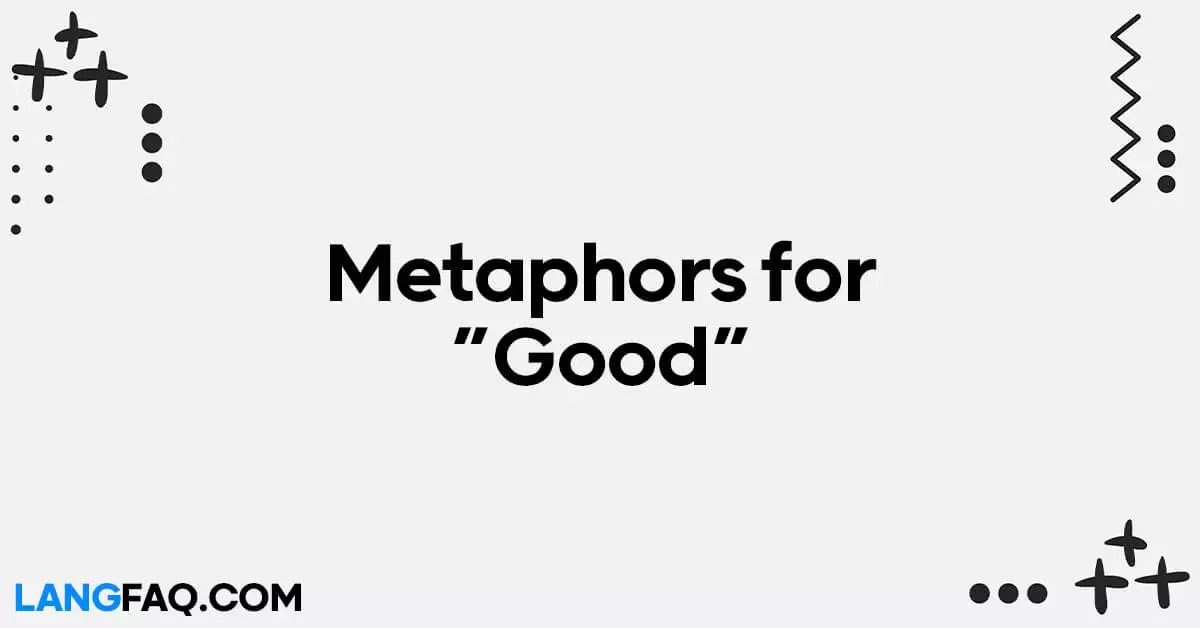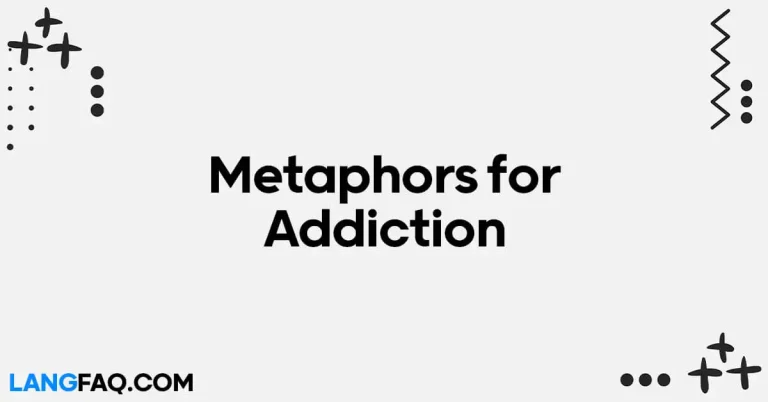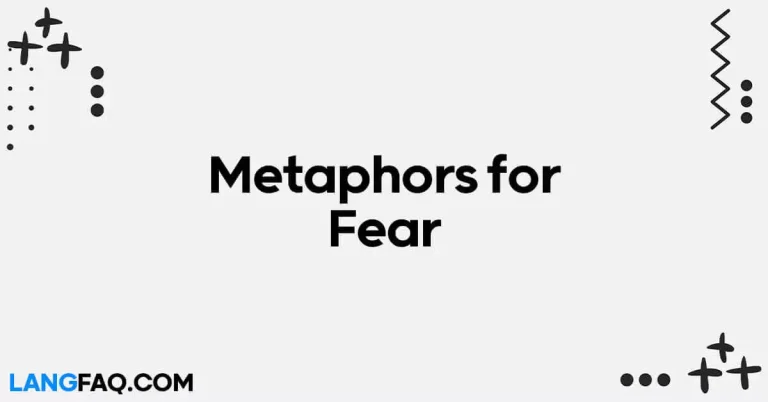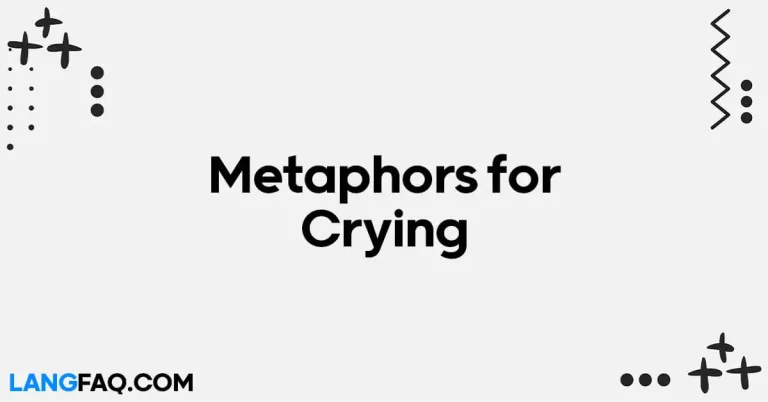In a world filled with challenges and uncertainties, the concept of “good” serves as a guiding light, illuminating our path towards a brighter future. This article delves deep into the realm of positivity, offering you a comprehensive list of 26 metaphors for good.
Each metaphor provides a unique perspective on the idea of goodness, allowing you to see the beauty and significance of positivity in various facets of life.
Goodness is a universal concept that transcends cultural boundaries and language barriers. It’s a fundamental aspect of human existence, shaping our thoughts, actions, and interactions with others.
Exploring metaphors for good not only enriches our language but also deepens our understanding of the positive forces that influence our lives. In this article, we’ll embark on a journey through these metaphors, shedding light on the intricate nuances of goodness.
26 Metaphors for Good
- The Guiding Star: Goodness is like a bright star in the night sky, guiding us in the right direction.
- The Golden Key: Goodness unlocks the doors to happiness and success, much like a golden key.
- The Warm Sunshine: Goodness spreads warmth and light, just like the gentle rays of the sun on a chilly morning.
- The Compassionate Heart: A good person has a heart overflowing with compassion, always ready to help others.
- The Steady Anchor: Goodness provides stability and support, like a reliable anchor in the stormy sea of life.
- The Melodious Symphony: Goodness harmonizes our lives, creating a beautiful symphony of positivity and kindness.
- The Healing Touch: Goodness has the power to heal emotional wounds, much like a soothing touch.
- The Refreshing Rain: Just as rain nourishes the earth, goodness refreshes our souls and revitalizes our spirits.
- The Protective Shield: Goodness shields us from negativity and adversity, like an impenetrable shield.
- The Blooming Flower: Goodness is like a flower that blossoms, bringing beauty and joy to the world.
- The Sparkling Diamond: Goodness shines brightly, just like a precious diamond, illuminating our lives.
- The Overflowing Cup: A good heart is like a cup overflowing with generosity and kindness.
- The Lighthouse: Goodness acts as a lighthouse, guiding us safely through the darkest of times.
- The Peaceful Oasis: Goodness provides a tranquil oasis in the midst of life’s chaos and challenges.
- The Supportive Pillar: Goodness is a pillar of strength, offering unwavering support to those in need.
- The Magic Wand: Goodness can work wonders, much like a magic wand that transforms lives.
- The Symphony Conductor: Like a skilled conductor, goodness orchestrates harmony and unity among people.
- The Fertile Soil: Goodness is the fertile soil in which positive relationships and experiences grow.
- The Nurturing Mother: Goodness nurtures and cares for us, like a loving mother tending to her child.
- The Guiding North Star: Goodness serves as a constant guide, much like the North Star guiding travelers.
- The Timeless Classic: Goodness never goes out of style, much like a timeless classic that endures.
- The Radiant Beacon: Goodness radiates like a beacon, drawing others towards its positive light.
- The Peaceful River: Goodness flows smoothly, bringing peace and tranquility wherever it goes.
- The Friendly Handshake: Goodness is like a friendly handshake, forging connections and friendships.
- The Spark of Inspiration: Goodness inspires us to be our best selves, sparking creativity and innovation.
- The Recipe for Joy: Goodness is the essential ingredient in the recipe for a joyful and fulfilling life.
These metaphors capture the essence of goodness and highlight its positive impact on our lives and the world around us.
The Guiding Star: A Beacon of Light in Your Life
The metaphor of “The Guiding Star” is a powerful symbol of goodness, representing a constant source of light and direction in our lives. Just as sailors rely on the North Star to navigate the seas, we turn to goodness to steer us through life’s challenges.
Definition and Usage
In both formal and informal contexts, “The Guiding Star” is used to describe someone or something that provides unwavering guidance, support, and inspiration. It signifies a dependable source of wisdom and direction.
Examples
- Formal: In a corporate setting, a mentor can be seen as “The Guiding Star” for young professionals, offering valuable career advice and leadership guidance.
- Informal: Among friends, you might refer to a wise and supportive friend as your “Guiding Star” in times of need.
Pros and Cons
- Pros: The metaphor emphasizes the reliability and constancy of goodness. It’s a universal symbol that resonates with people from diverse backgrounds.
- Cons: Overuse of this metaphor may make it lose its impact, so it should be used thoughtfully.
Grammar and Usage Tips
- Use “The Guiding Star” when you want to highlight the consistent and unwavering nature of someone’s guidance or support.
The Golden Key: Unlocking Happiness and Success
Imagine goodness as “The Golden Key” that opens the doors to happiness and success. This metaphor suggests that embracing goodness can lead to positive outcomes and opportunities in life.
Definition and Usage
“The Golden Key” is a metaphor that signifies the idea of goodness being a valuable tool or approach that can lead to favorable results. It is suitable for both formal and informal contexts.
Examples
- Formal: In a business presentation, you can explain how ethical practices are often seen as “The Golden Key” to building a reputable brand.
- Informal: Among friends, you might say that a positive attitude is the “Golden Key” to enjoying life to the fullest.
Pros and Cons
- Pros: This metaphor conveys the idea of goodness being a powerful tool for achieving one’s goals. It is relatable and memorable.
- Cons: Be cautious not to oversimplify complex situations by relying solely on this metaphor.
Grammar and Usage Tips
- Use “The Golden Key” when you want to emphasize how goodness can lead to positive outcomes and success.
The Warm Sunshine: Spreading Light and Positivity
Goodness is often compared to “The Warm Sunshine” because it brings light, warmth, and positivity into our lives. This metaphor highlights the uplifting and comforting nature of goodness.
Definition and Usage
In various settings, “The Warm Sunshine” is used to describe the way goodness brightens our days and brings positivity. It can be used formally and informally.
Examples
- Formal: In a motivational speech, you can inspire your audience by explaining how acts of kindness are like “The Warm Sunshine” that dispels darkness.
- Informal: When consoling a friend, you might say that their support feels like “The Warm Sunshine” on a gloomy day.
Pros and Cons
- Pros: This metaphor paints a vivid and relatable picture of the impact of goodness. It conveys a sense of comfort and hope.
- Cons: Avoid using this metaphor in situations where a more serious tone is required.
Grammar and Usage Tips
- Use “The Warm Sunshine” when you want to highlight the positive and comforting nature of goodness.
The Compassionate Heart: Nurturing Kindness and Empathy
“The Compassionate Heart” metaphor embodies the idea that goodness resides in individuals who possess empathy, kindness, and a genuine concern for others. It symbolizes the capacity to understand and care for people’s feelings and needs.
Definition and Usage
In both formal and informal contexts, “The Compassionate Heart” refers to individuals who demonstrate exceptional empathy and kindness. It is often used to praise someone for their caring and understanding nature.
Examples
- Formal: In a professional recommendation letter, you can commend a colleague for their “Compassionate Heart” and ability to work well in teams.
- Informal: When thanking a friend for their support during a difficult time, you might express gratitude for their “Compassionate Heart.”
Pros and Cons
- Pros: This metaphor emphasizes the importance of empathy and kindness in personal and professional relationships. It is a heartwarming and universally understood symbol.
- Cons: Overuse of this metaphor may diminish its impact, so it’s best used selectively.
Grammar and Usage Tips
- Use “The Compassionate Heart” when you want to highlight someone’s exceptional empathy, kindness, and caring nature.
The Steady Anchor: Providing Stability and Support
Goodness is often compared to “The Steady Anchor” because it offers stability and support during life’s turbulent times. This metaphor signifies the reliability and strength that goodness brings to our lives.
Definition and Usage
“The Steady Anchor” metaphor represents the idea that goodness acts as a source of stability and support. It is suitable for both formal and informal communication.
Examples
- Formal: In a leadership seminar, you can explain how ethical leadership serves as “The Steady Anchor” that keeps organizations grounded during challenges.
- Informal: When consoling a friend going through a tough period, you might reassure them that your friendship is their “Steady Anchor.”
Pros and Cons
- Pros: This metaphor conveys the idea of goodness as a source of strength and reliability. It is relatable and reassuring.
- Cons: Avoid using this metaphor in situations that require a more lighthearted or casual tone.
Grammar and Usage Tips
- Use “The Steady Anchor” when you want to emphasize how goodness provides stability and support during difficult times.
The Melodious Symphony: Harmonizing Life’s Elements
Imagine goodness as “The Melodious Symphony” that harmonizes various aspects of life. This metaphor suggests that goodness brings balance, unity, and beauty to our experiences.
Definition and Usage
“The Melodious Symphony” represents the idea that goodness creates harmony and unity in different aspects of life. It can be used both formally and informally.
Examples
- Formal: In a keynote speech about work-life balance, you can describe how a balanced lifestyle is like “The Melodious Symphony” that enhances productivity.
- Informal: When explaining the importance of cooperation to a friend, you might say that teamwork is the “Melodious Symphony” that makes projects successful.
Pros and Cons
- Pros: This metaphor vividly illustrates how goodness can bring harmony and beauty to life. It is memorable and inspiring.
- Cons: Avoid using this metaphor in situations where it might be perceived as overly poetic or abstract.
Grammar and Usage Tips
- Use “The Melodious Symphony” when you want to emphasize the role of goodness in creating balance and unity in various aspects of life.
These metaphors for goodness capture its multifaceted nature and emphasize the positive impact it has on our lives. They provide powerful imagery that resonates with people from all walks of life, making the concept of goodness more relatable and inspiring.
The Healing Touch: Mend Broken Hearts and Wounded Spirits
“The Healing Touch” metaphor paints a picture of goodness as a source of comfort and recovery. It signifies the power of goodness to mend emotional wounds and uplift those who are hurting.
Definition and Usage
In both formal and informal contexts, “The Healing Touch” refers to the soothing and restorative impact of goodness. It’s often used to describe the actions of individuals who offer solace and emotional support.
Examples
- Formal: In a therapeutic setting, you can discuss how empathy and understanding can provide patients with “The Healing Touch” they need for recovery.
- Informal: When consoling a friend going through a tough breakup, you might remind them that time and good friends can provide the “Healing Touch” they require.
Pros and Cons
- Pros: This metaphor emphasizes the comforting and rejuvenating nature of goodness. It is relatable and emotionally resonant.
- Cons: Avoid using this metaphor in situations where a more objective or factual tone is necessary.
Grammar and Usage Tips
- Use “The Healing Touch” when you want to highlight how goodness can bring comfort and healing to emotional pain and suffering.
The Gentle Whisper: Guiding Us Toward Acts of Kindness
Goodness often communicates with us in the subtlest of ways, much like “The Gentle Whisper.” This metaphor signifies the quiet nudges toward acts of kindness and compassion.
Definition and Usage
“The Gentle Whisper” metaphor represents the idea that goodness often inspires us through gentle and subtle cues. It can be used in both formal and informal conversations.
Examples
- Formal: In a leadership seminar, you can discuss how great leaders have an innate ability to hear “The Gentle Whisper” of ethical decision-making.
- Informal: When explaining the importance of being considerate to a friend, you might mention how small gestures can be “The Gentle Whisper” that reminds us to be kind.
Pros and Cons
- Pros: This metaphor conveys the idea of goodness as a subtle yet powerful influence on our behavior. It encourages reflection and mindfulness.
- Cons: Avoid using this metaphor in situations that require a more direct or assertive approach.
Grammar and Usage Tips
- Use “The Gentle Whisper” when you want to highlight the quiet, persuasive nature of goodness and its role in inspiring acts of kindness.
The Sunlight of Joy: Brightening Our Spirits
Goodness is often likened to “The Sunlight of Joy” because it has the power to infuse our lives with happiness and positivity. This metaphor signifies the uplifting and energizing nature of goodness.
Definition and Usage
“The Sunlight of Joy” metaphor represents the idea that goodness can bring joy and vitality into our lives. It is suitable for both formal and informal communication.
Examples
- Formal: In a motivational workshop, you can discuss how cultivating gratitude can be like inviting “The Sunlight of Joy” into one’s life.
- Informal: When complimenting a friend on their positive attitude, you might say that they bring “The Sunlight of Joy” to every gathering.
Pros and Cons
- Pros: This metaphor vividly portrays how goodness can brighten our spirits and bring happiness. It is relatable and uplifting.
- Cons: Avoid using this metaphor in situations that require a more serious or somber tone.
Grammar and Usage Tips
- Use “The Sunlight of Joy” when you want to emphasize how goodness can fill our lives with happiness and positivity.
The Catalyst for Change: Inspiring Positive Transformation
Goodness serves as “The Catalyst for Change” by inspiring individuals and communities to take positive actions and create a better world. This metaphor signifies how goodness can ignite the spark of transformation.
Definition and Usage
In both formal and informal contexts, “The Catalyst for Change” represents the idea that goodness can inspire people to initiate positive changes in their lives and the world around them.
Examples
- Formal: In a business presentation on corporate social responsibility, you can discuss how ethical practices act as “The Catalyst for Change” in society.
- Informal: When motivating a friend to volunteer for a charitable cause, you might explain how their involvement can be “The Catalyst for Change” in the community.
Pros and Cons
- Pros: This metaphor highlights how goodness can lead to positive transformations and inspire action. It is motivational and forward-looking.
- Cons: Avoid using this metaphor in situations where a more cautionary or conservative approach is warranted.
Grammar and Usage Tips
- Use “The Catalyst for Change” when you want to emphasize how goodness can inspire individuals and communities to make positive and impactful changes.
The Nourishing Seed: Fostering Personal Growth
Much like a seed needs nourishment to grow, goodness nurtures personal growth, self-improvement, and spiritual development. This metaphor signifies how goodness provides the essential elements for personal advancement.
Definition and Usage
“The Nourishing Seed” metaphor represents the idea that goodness is like the fertile soil that enables individuals to grow and flourish. It is applicable in both formal and informal contexts.
Examples
- Formal: In a self-help seminar, you can explain how positive affirmations and kindness to oneself can be the “Nourishing Seed” for personal growth.
- Informal: When advising a friend on their journey of self-improvement, you might suggest that self-compassion serves as the “Nourishing Seed” for personal development.
Pros and Cons
- Pros: This metaphor vividly illustrates how goodness fosters personal growth and development. It is motivating and relatable.
- Cons: Avoid using this metaphor in situations that require a more objective or detached tone.
Grammar and Usage Tips
- Use “The Nourishing Seed” when you want to emphasize how goodness plays a crucial role in nurturing personal growth and self-improvement.
The Bridge of Understanding: Connecting People
Goodness serves as “The Bridge of Understanding” by connecting people from diverse backgrounds and fostering empathy and unity. This metaphor signifies how goodness promotes mutual understanding and harmonious coexistence.
Definition and Usage
In both formal and informal communication, “The Bridge of Understanding” represents the idea that goodness bridges the gap between individuals and promotes inclusivity and empathy.
Examples
- Formal: In a diversity and inclusion workshop, you can discuss how acts of kindness can act as “The Bridge of Understanding” among employees from different backgrounds.
- Informal: When explaining the importance of empathy to a friend, you might say that it serves as a “Bridge of Understanding” in relationships.
Pros and Cons
- Pros: This metaphor emphasizes how goodness can bring people together and foster understanding. It promotes unity and empathy.
- Cons: Avoid using this metaphor in situations that require a more analytical or technical approach.
Grammar and Usage Tips
- Use “The Bridge of Understanding” when you want to highlight how goodness can connect people from diverse backgrounds and promote empathy and inclusivity.
The Symphony of Harmony: Creating Unity and Cooperation
When goodness prevails, it creates a “Symphony of Harmony” in our relationships and interactions. This metaphor signifies how goodness can orchestrate unity, cooperation, and a sense of togetherness.
Definition and Usage
“The Symphony of Harmony” represents the idea that goodness is like a conductor, ensuring that people work together smoothly and in unity. It is applicable in both formal and informal contexts.
Examples
- Formal: In a team-building seminar, you can discuss how effective leadership can create a “Symphony of Harmony” in the workplace.
- Informal: When talking to a friend about resolving conflicts, you might suggest that open communication can lead to a “Symphony of Harmony” in relationships.
Pros and Cons
- Pros: This metaphor vividly portrays how goodness can lead to unity and cooperation. It encourages collaboration and teamwork.
- Cons: Avoid using this metaphor in situations that require a more individualistic or competitive approach.
Grammar and Usage Tips
- Use “The Symphony of Harmony” when you want to emphasize how goodness can create unity and cooperation among individuals and groups.
These metaphors for goodness showcase its transformative power and its ability to inspire positive change, personal growth, unity, and cooperation. Whether in formal or informal contexts, they make the concept of goodness more relatable and illustrate its impact on individuals and communities.
FAQs
What are metaphors for good?
Metaphors for good are creative expressions that symbolize positivity, kindness, and virtue. They provide alternative ways to describe the concept of “good” in various contexts.
How can I incorporate goodness into my daily life?
You can embrace goodness by practicing acts of kindness, fostering empathy, and making ethical choices. Small gestures of goodness can have a profound impact on your life and the lives of others.
Why is goodness important?
Goodness is essential for building strong relationships, creating a harmonious society, and finding fulfillment in life. It promotes positivity, compassion, and personal growth.
Can goodness be learned?
Yes, goodness can be cultivated and learned through conscious efforts. By choosing to prioritize kindness, empathy, and ethical behavior, individuals can develop their capacity for goodness.
How does goodness contribute to personal well-being?
Goodness enhances personal well-being by reducing stress, promoting positive emotions, and strengthening social connections. It leads to a happier and more fulfilling life.
Is goodness the same as perfection?
No, goodness is not the same as perfection. Goodness acknowledges our imperfections and strives for moral integrity and kindness, rather than flawless performance.
Conclusion
In a world that often emphasizes the challenges and negativity, exploring the depth and beauty of goodness through metaphors is a refreshing journey. These 26 metaphors for good remind us of the transformative power of positivity and inspire us to be better versions of ourselves. Let goodness be our guiding star as we navigate the complexities of life, spreading kindness and light along the way.







